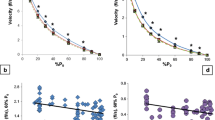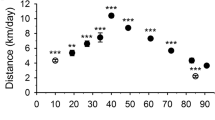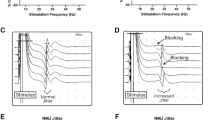Abstract
The involvement of glutathione in the response of skeletal muscle following repetitive, high-intensity mechanical loading is not known. We examined the influence of a glutathione antagonist [l-Buthionine Sulfoximine (BSO)] had on the adaptability of skeletal muscle during chronic mechanical loading via stretch-shortening contractions (SSCs) in young and old rats. Left dorsiflexor muscles of young (12 weeks, N = 16) and old (30 months, N = 16), vehicle- and BSO-treated rats were exposed three times per week for 4.5-weeks to a protocol of 80 maximal SSCs per exposure in vivo. Skeletal muscle response to the SSC exposure was characterized by muscle performance, as well as muscle wet-weight and quantitative morphological analyses following the exposure period. Results reveal that generally, muscle performance increased in the young rats only following chronic SSC exposure. BSO treatment had no effect on muscle performance or morphology following the chronic SSC exposure in old rats. Muscle wet-weight was increased following exposure compared with the contra-lateral control limb, irrespective of age (p < 0.05). Muscle cross-sectional area increased approximately 20% with SSC loading in the young, vehicle rats, while increasing approximately 10% with SSC loading in old, vehicle rats compared with control rat muscle. No degenerative myofibers were noted in either age group, but edema were increased as a result of aging (p < 0.05). We conclude that our results indicate that glutathione depletion does not adversely affect muscle performance or morphology in old rats. Nevertheless, we continue to show that aging negatively influences performance and morphology following chronic SSC exposure.










Similar content being viewed by others
References
Alway SE (1995) Slowing of contractile properties in quail skeletal muscle with aging. J Gerontol A Biol Sci Med Sci 50A:B26–B33
Alway SE, Degens H, Krishnamurthy G, Smith CA (2002) Potential role for Id myogenic repressors in apoptosis and attenuation of hypertrophy in muscles of aged rats. Am J Physiol Cell Physiol 283:C66–C76
Baker BA, Mercer RR, Geronilla KB, Kashon ML, Miller GR, Cutlip RG (2006) Stereological analysis of muscle morphology following exposure to repetitive stretch-shortening cycles in a rat model. Appl Physiol Nutr Metab 31:167–179
Bejma J, JI LL (1999) Aging and acute exercise enhance free radical generation in rat skeletal muscle. J Appl Physiol 87:465–470
Brooks SV, Faulkner JA (1990) Contraction-induced injury: recovery of skeletal muscles in young and old mice. Am J Physiol 258:C436–C442
Brooks SV, Faulkner JA (1996) The magnitude of the initial injury induced by stretches of maximally activated muscle fibres of mice and rats increases in old age. J Physiol 497(Pt 2):573–580
Brooks SV, Opiteck JA, Faulkner JA (2001) Conditioning of skeletal muscles in adult and old mice for protection from contraction-induced injury. J Gerontol A Biol Sci Med Sci 56:B163–B171
Carson JA, Alway SE, Yamaguchi M (1995) Time course of hypertrophic adaptations of the anterior latissimus dorsi muscle to stretch overload in aged Japanese quail. J Gerontol A Biol Sci Med Sci 50:B391–B398
Conboy IM, Conboy MJ, Wagers AJ, Girma ER, Weissman IL, Rando TA (2005) Rejuvenation of aged progenitor cells by exposure to a young systemic environment. Nature 433:760–764
Cutlip RG, Stauber WT, Willison RH, Mcintosh TA, Means KH (1997) Dynamometer for rat plantar flexor muscles in vivo. Med Biol Eng Comput 35:540–543
Cutlip RG, Geronilla KB, Baker BA, Kashon ML, Miller GR, Schopper AW (2004) Impact of muscle length during stretch-shortening contractions on real-time and temporal muscle performance measures in rats in vivo. J Appl Physiol 96:507–516
Cutlip RG, Baker BA, Geronilla KB, Mercer RR, Kashon ML, Miller GR, Murlasits ZS, Alway SE (2006) Chronic exposure to stretch-shortening contractions results in skeletal muscle adaptation in young rats and maladaptation in old rats. Appl Physiol Nutr Metab 31:573–587
Davis J, Kaufman KR, Lieber RL (2003) Correlation between active and passive isometric force and intramuscular pressure in the isolated rabbit tibialis anterior muscle. J Biomech 36:505–512
Degens H, Alway SE (2003) Skeletal muscle function and hypertrophy are diminished in old age. Muscle Nerve 27:339–347
Ettema GJ (1996) Mechanical efficiency and efficiency of storage and release of series elastic energy in skeletal muscle during stretch-shorten cycles. J Exp Biol 199(Pt 9):1983–1997
Geronilla KB, Miller GR, Mowrey KF, Wu JZ, Kashon ML, Brumbaugh K, Reynolds J, Hubbs A, Cutlip RG (2003) Dynamic force responses of skeletal muscle during stretch-shortening cycles. Eur J Appl Physiol 90:144–153
Gonzalez E, Messi M, Delbono O (2000) Contractile properties of single intact mouse extensor digitorum longus (EDL), flexor digitorum brevis (FDB) and soleus muscle fibers. J Memb Biol 178:175–183
Ingalls CP, Warren GL, Lowe DA, Boorstein DB, Armstrong RB (1996) Differential effects of anesthetics on in vivo skeletal muscle contractile function in the mouse. J Appl Physiol 80:332–340
Ingalls CP, Warren GL, Williams JH, Ward CW, Armstrong RB (1998) E-C coupling failure in mouse EDL muscle after in vivo eccentric contractions. J Appl Physiol 85:58–67
Klitgaard H, Brunet A, Maton B, Lamaziere C, Lesty C, Monod H (1989a) Morphological and biochemical changes in old rat muscles: effect of increased use. J Appl Physiol 67:1409–1417
Klitgaard H, Marc R, Brunet A, Vandewalle H, Monod H (1989b) Contractile properties of old rat muscles: effect of increased use. J Appl Physiol 67:1401–1408
Leeuwenburgh C, Ji LL (1995) Glutathione depletion in rested and exercised mice: biochemical consequence and adaptation. Arch Biochem Biophys 316:941–949
Lowe DA, Lund T, Alway SE (1998) Hypertrophy-stimulated myogenic regulatory factor mRNA increases are attenuated in fast muscle of aged quails. Am J Physiol 275:C155–C162
Lowe D, Thomas D, Thompson L (2002) Force generation, but not myosin ATPase activity, declines with age in rat muscle fibers. Am J Physiol 283:187–192
Martensson J, Meister A (1989) Mitochondrial damage in muscle occurs after marked depletion of glutathione and is prevented by giving glutathione monoester. Proc Natl Acad Sci USA 86:471–475
McBride TA, Gorin FA, Carlsen RC (1995) Prolonged recovery and reduced adaptation in aged rat muscle following eccentric exercise. Mech Ageing Dev 83:185–200
McBride JM, Kraemer WJ, Triplett-Mcbride T, Sebastianelli W (1998) Effect of resistance exercise on free radical production. Med Sci Sports Exerc 30:67–72
Meister A (1991) Glutathione deficiency produced by inhibition of its synthesis, and its reversal; applications in research and therapy. Pharmac Ther 51:155–194
Payne AM, Delbono O (2004) Neurogenesis of excitation-contraction uncoupling in aging skeletal muscle. Exerc Sport Sci Rev 32:36–40
Stevens ED (1996) Effect of phase of stimulation on acute damage caused by eccentric contractions in mouse soleus muscle. J Appl Physiol 80:1958–1962
Stevens ED, Faulkner JA (2000) The capacity of mdx mouse diaphragm muscle to do oscillatory work. J Physiol 522 (Pt 3):457–466
Tidball JG (2005) Inflammatory processes in muscle injury and repair. Am J Physiol Regul Integr Comp Physiol 288:R345–R353
Uchiyama S, Tsukamoto H, Yoshimura S, Tamaki T (2006) Relationship between oxidative stress in muscle tissue and weight-lifting-induced muscle damage. Eur J Physiol 452:109–116
Underwood EE (1970) Quantatative stereology. Addison-Wesley Publishing Co, Reading
Urso ML, Clarkson PM (2003) Oxidative stress, exercise, and antioxidant supplementation. Toxicology 189:41–54
Watanabe T, Sagisaka H, Arakawa S, Shibaya Y, Watanabe M, Igarashi I, Tanaka K, Totsuka S, Takasaki W, Manabe S (2003) A novel model of continuous depletion of glutathione in mice treated with l-buthionine (S, R)-sulfoximine. J Toxicol Sci 28:455–469
Weibel ER (1972) The value of stereology in analysing structure and function of cells and organs. J Microsc 95:3–13
Weibel ER (1974) Selection of the best method in stereology. J Microsc 100:261–269
Weibel ER (1975) Quantitation in morphology: possibilities and limits. Beitr Pathol 155:1–17
Willems ME, Stauber WT (2001) Force deficits after repeated stretches of activated skeletal muscles in female and male rats. Acta Physiol Scand 172:63–67
Zerba E, Komorowski TE, Faulkner JA (1990) Free radical injury to skeletal muscles of young, adult, and old mice. Am J Physiol 258:C429–C435
Acknowledgments
The authors would like to thank Drs. Paul Nicolaysen, Kristine Krajnak, and Pius Joseph of the National Institute for Occupational Safety and Health (NIOSH) for their critical review and comments regarding the preparation manuscript.
Author information
Authors and Affiliations
Corresponding author
Additional information
Communicated by Roberto Bottinelli.
The findings and conclusions in this report are those of the author(s) and do not necessarily represent the views of the National Institute for Occupational Safety and Health.
Rights and permissions
About this article
Cite this article
Baker, B.A., Hollander, M.S., Kashon, M.L. et al. Effects of glutathione depletion and age on skeletal muscle performance and morphology following chronic stretch-shortening contraction exposure. Eur J Appl Physiol 108, 619–630 (2010). https://doi.org/10.1007/s00421-009-1258-4
Accepted:
Published:
Issue Date:
DOI: https://doi.org/10.1007/s00421-009-1258-4




